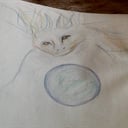What is the most widely used chemical solvent in 'dry cleaning' first synthesized by Michael Faraday in 1821?
Dry cleaning is a cleaning process of clothing and textiles using a chemical solvent only. The 'tetrachloroethylene' (or perchloroethylene or ''perc'') is the most widely used solvent. Michael Faraday (September 1791- August 1867) first synthesized 'tetrachloroethylene' by thermal decomposition of hexachloroethane in 1821. The process is chlorination of hydrocarbon at high temperature. The intermediate product 'hexachloroethane' gives out 'tetrachloroethane': Hydrocarbons+Direct chlorination= Hexachloroethane=high temperature=C2Cl4 (tetrachloroethylene). Tetrachloroethylene is chlorocarbon with formula: Cl2C=CCl2.
It is a colorless liquid widely used for dry cleaning of fabrics. It has a sweet odor detectable by most people at a concentration of 1 part per million (ppm). It is an excellent solvent and is volatile, highly stable, and nonflammable. Due to its stability, C2Cl4 is readily recycled. It has low toxicity. It can, however, cause color loss, especially at higher temperatures. According to the US Environmental Protection Agency report of 1976, the quantity of tetrachloroethylene produced in the US in 1973 totalled 320,000 metric tons (706 million pound). The worldwide production was about 1 million metric tons (980,000 long tons, 1,100,000 short tons) in 1985. By the mid-1930s, the dry cleaning industry had adopted 'tetrachloroethylene' as the solvent. Thomas I. Jennings is the inventor and first to patent the commercial dry cleaning process, on March 3, 1821.
More Info:
en.wikipedia.org







